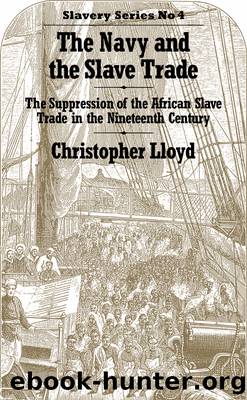The Navy and the Slave Trade by Christopher Lloyd

Author:Christopher Lloyd [Lloyd, Christopher]
Language: eng
Format: epub
Tags: History, General
ISBN: 9781136257933
Google: ukCVkwpDrNIC
Publisher: Routledge
Published: 2012-11-12T15:54:16+00:00
Chapter XI
The Capture of Lagos
THE alternative to Palmerstonâs method of suppression by treaty and the use of naval force was to annex the chief slave exporting areas of Africa. This policy found no favour with the statesmen of the early-Victorian period. Every party was averse to taking on fresh colonial commitments. Many, such as Disraeli in his unregenerate days, were opposed to the idea of holding colonies at all; he changed his mind on this, as on other matters, but Gladstone disapproved of annexation to the end. The sooner we parted from our colonies the better, said Cobden, the Free Traders and the Little Englanders. At the same time the determination to suppress the African Slave Trade continued firm, though not as widespread as in the early years of the Abolitionist movement. As time went on and the traditional method brought no decisive success, as the growth of legitimate commerce continued to languish in the face of the more lucrative trade in slaves, the British Government was forced along the road to annexation. From long and expensive experience it was found that the only way to close Whydah and the Lagos lagoons against the depredations of the slave dealers was to annex some strategic point on the coast; similarly, and with even greater reluctance, it was at length conceded that the only way to stop the Arab trade was to annex part of the East African coastline. In the fifty years preceding the Scramble for Africa such views were not popular at home: they were only held by naval officers, missionaries and merchants on the spot. The story of the annexation of Lagos shows how slowly, and almost accidentally, the British began to embark on a policy which ultimately gained for her those possessions in Africa which amply compensated for a long and single-handed humanitarian crusade.
From the beginning of European colonisation in West Africa treaties for the concession of land or trading rights had been signed with the native chiefs. In this way the governors of Sierra Leone and the Gambia extended their colonies piece by piece by the purchase of neighbouring lands, and the merchants of the Royal African Company gained concessions to establish their forts along the northern seaboard of the Gulf of Guinea. When the policy of suppressing the Slave Trade was adopted it was a natural extension of this practice to insert a clause requiring the chief in question to refrain from participating in the trade in return for substantial subsidies. As time went on, anti-slave trade treaties which had nothing to do with territorial concessions became frequent. We have seen how Aberdeenâs letter in 1842 necessitated many more of these treaties to avoid such legal imbroglios as had resulted from Denmanâs destruction of the Gallinas factories. Within the next eight years forty-two such treaties were signed, and the same practice was later adopted on the East African coast.
An example of such a native treaty was that signed by Captain W. Tucker of H.M.S. Iris with King Pepple and the chiefs of the Bonny in the year 1841.
Download
This site does not store any files on its server. We only index and link to content provided by other sites. Please contact the content providers to delete copyright contents if any and email us, we'll remove relevant links or contents immediately.
African Origin World Writing Systems by Clyde Winters(634)
A Soldier of the Legion - An Englishman's Adventures Under the French Flag in Algeria and Tonquin by George Manington(361)
The Navy and the Slave Trade by Christopher Lloyd(343)
The Tulsa Massacre of 1921: The Controversial History and Legacy of Americaâs Worst Race Riot by Charles River Editors(144)
Afropolitan Projects by Anima Adjepong(122)
The Hidden Ireland â A Study of Gaelic Munster in the Eighteenth Century by Daniel Corkery(114)
Black Scare Red Scare by Charisse Burden-Stelly(103)
Colonization and missions by Tracy Joseph(100)
Advertisements for Runaway Slaves in Virginia, 1801-1820 by Daniel Meaders Daniel E. Meaders(91)
Bedouin Tribes of the Euphrates by W.S. Blunt(91)
The Hidden Patients. North African Women in French Colonial Psychiatry by Nina Salouâ Studer(84)
Heritage Conservation in the United States: Enhancing the Presence of the Past by John H. Sprinkle Jr(79)
George Forty by The Desert War(77)
Recent Dearomatization Strategies of Benzofurans and Benzothiophenes by Unknown(72)
The Last Train North by Clifton M. Taulbert(70)
Ten Years of Secret Diplomacy by E D. Morel(70)
African Modernities and Mobilities: An Historical Ethnography of Kom, Cameroon, C. 1800-2008 by Gam Nkwi(66)
Total War and "Modernization" by Yasushi Yamanouchi J. Victor Koschmann Ryuichi Narita(66)
Moroccan Drama: 1900-1955 by Rom Landau(65)
